建议收藏:vue-cli2 与vue-cli3,vue2与vue3 初始化项目,解析区别
vue-cli2 与 vue-cli3 的区别
vue-cli3是基于webpack4打造,vue-cli2是基于webpack3 vue-cli3的设计原则是“0配置”,移除(隐藏)配置文件build和config等目录 vue-cli3提供了vue ui 命令,提供了可视化配置 vue-cli3移除了static文件夹,新增了public文件夹,并且将index.html移动到public中 使用vue-cli2初始化项目 vue init webpack 项目名,生成的目录 使用vue-cli3初始化项目 vue create 项目名,生成的目录
例子1:
vue2
vue-cli 2.5.2 初始化项目
vue init webpack lujh(项目名称)
项目截图:
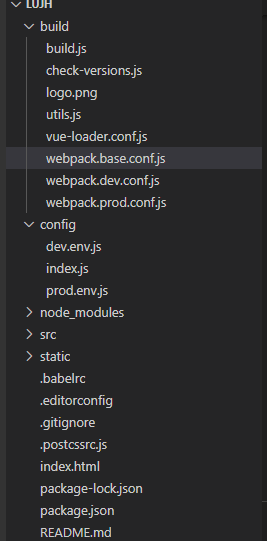
文件解析如下:
build 文件夹:webpack的一些相关配置; config 文件夹:项目开发环境和生产环境的一些相关配置; node_modules 文件夹 :这里存放的是安装包,比如webpack、第三方插件库、项目的依赖文件; src 文件夹:我们将要写的代码放在这里面,打包上线时会进行编译、压缩等操作。 static 文件夹:这里存放的是一些静态文件比如图片、css文件、不需要进行压缩的js文件,打包时这个文件夹将原封不动的放到dist(打包时自动生产的文件夹)文件夹下面。 .babelrc 文件:ES6语法编译配置,主要是将ES 转成ES 需要适配那些浏览器 .editorconfig 文件:定义代码格式,对代码的风格进行一个统一。 .gitignore 文件:git上传需要忽略的文件格式 .postcssrc.js 文件:postcss配置文件 index.html 文件:要进行访问的首页面 package-lock.json 文件:锁定依赖模块和子模块的版本号 package.json 文件:项目基本信息,包依赖信息等 README.md 文件:项目说明文件
1、package.json 文件
当我们在命令行时 npm run dev 的时候程序执行的是package.json文件的“script”脚本里的“dev”命令;
脚本解析:
“webpack-dev-server” 服务器
“--inline” 是重新加载改变的部分,不会刷新页面
“--progress”是启动项目时显示进度百分比
“--config build/webpack.dev.conf.js” 是执行build下面的webpack.dev.conf.js 配置文件。
其他属性比如:
“--open” 是启动项目后自动在浏览器打开项目,其它配置可以查看相关文档(https://www.webpackjs.com/configuration/dev-server/#devserver)。
“start” 和“dev”的作用是一样的,
“build” 的作用是执行 build下的build.js文件,将当前的项目进行打包,打包后生成一个dist文件夹,放在其里面。
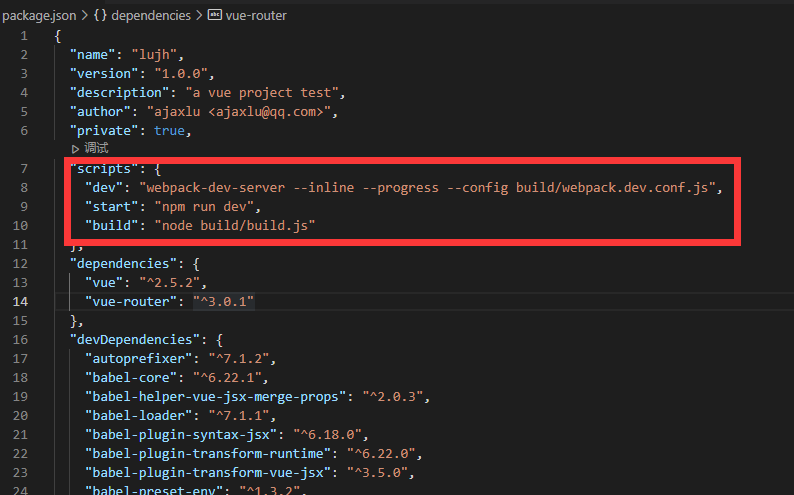
2、webpack.dev.conf.js文件是我们在开发环境下的webpack配置文件,entry(入口文件)、output(输出文件)、loader ,这些都是必备的,而一些plugins(插件)已经在对应的环境文件(webpack.dev.config.js、webpack.prod.config.js)中进行了配置:
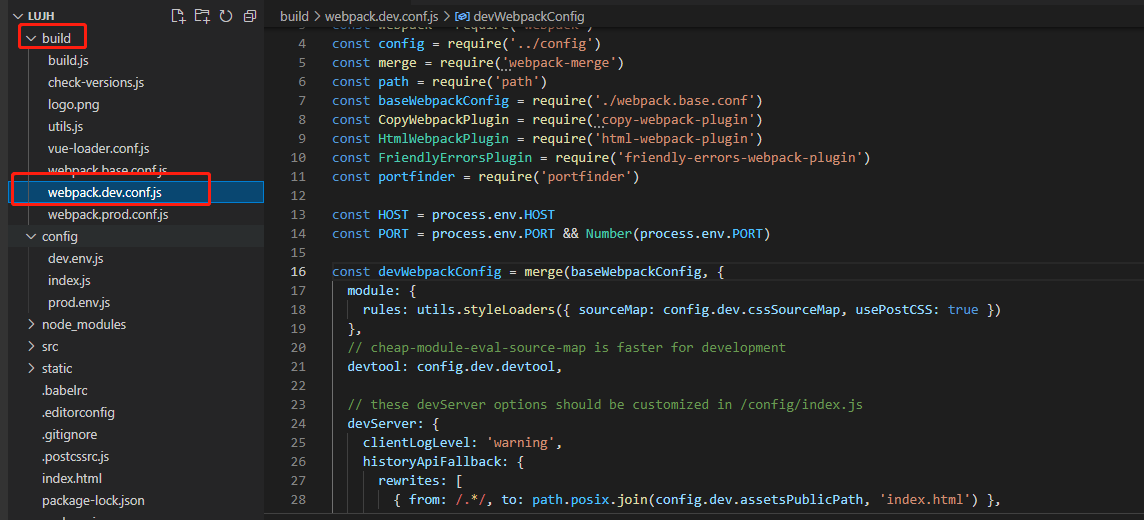
解析如下:
'use strict' const utils = require('./utils') //引入的工具包 const webpack = require('webpack') //引入webpack包 const config = require('../config') //引入 config下的index.js文件 const merge = require('webpack-merge') //合并配置文件 const path = require('path') //node的path模块,对路径进行处理 const baseWebpackConfig = require('./webpack.base.conf') //将生产和开发环境下共用的配置文件进行了抽离形成了改文件 const CopyWebpackPlugin = require('copy-webpack-plugin') //拷贝插件 const HtmlWebpackPlugin = require('html-webpack-plugin') //加载html模块 const FriendlyErrorsPlugin = require('friendly-errors-webpack-plugin') //友好的错误提示插件 const portfinder = require('portfinder') //在当前机器上找一个可打开的端口号,默认是8080,如果端口号被占用则重新寻找可打开的端口号。 const HOST = process.env.HOST const PORT = process.env.PORT && Number(process.env.PORT) const devWebpackConfig = merge(baseWebpackConfig, { //利用merge插件将 baseWebpackConfig 配置与当前配置进行合并 module: { rules: utils.styleLoaders({ sourceMap: config.dev.cssSourceMap, usePostCSS: true }) //引入utils中一些css-loader和postcss-loader }, devtool: config.dev.devtool, //控制是否生成以及如何生成源码映射,这里引入的是config下的index.js的 “devtool: 'cheap-module-eval-source-map'”, // these devServer options should be customized in /config/index.js // dev-server的配置 devServer: { clientLogLevel: 'warning', //当使用inline mode,devTools的命令行中将会显示一些调试信息 historyApiFallback: { //当使用 HTML5 History API 时,任意的 404 响应都可能需要被替代为 index.html rewrites: [ { from: /.*/, to: path.posix.join(config.dev.assetsPublicPath, 'index.html') }, ], }, hot: true, //启用 webpack 的模块热替换特性 contentBase: false, // since we use CopyWebpackPlugin. compress: true, host: HOST || config.dev.host, //要开启的域名,可在package.json中的“dev”命令中进行配置 port: PORT || config.dev.port, //要开启的端口号,可在package.json中的“dev”命令中进行配置 open: config.dev.autoOpenBrowser,//是否自动在浏览器中打开,可在package.json中的“dev”命令中进行配置 overlay: config.dev.errorOverlay ? { warnings: false, errors: true } : false, publicPath: config.dev.assetsPublicPath, // proxy: config.dev.proxyTable, //当出现跨域时设置代理,这里引入了config下的index.js的配置 quiet: true, // necessary for FriendlyErrorsPlugin 启用 quiet 后,除了初始启动信息之外的任何内容都不会被打印到控制台。这也意味着来自 webpack 的错误或警告在控制台不可见 watchOptions: { poll: config.dev.poll, } }, plugins: [ //插件部分 new webpack.DefinePlugin({ //配置全局变量 'process.env': require('../config/dev.env') }), new webpack.HotModuleReplacementPlugin(), // 模块热替换它允许在运行时更新各种模块,而无需进行完全刷新 new webpack.NamedModulesPlugin(), // HMR shows correct file names in console on update. new webpack.NoEmitOnErrorsPlugin(), // 这个插件的作用是在热加载时直接返回更新文件名,而不是文件的id。 // https://github.com/ampedandwired/html-webpack-plugin new HtmlWebpackPlugin({ //打包时生成index.html并且自动加载app.js文件 <!-- built files will be auto injected --> filename: 'index.html', template: 'index.html', inject: true }), // copy custom static assets new CopyWebpackPlugin([ { from: path.resolve(__dirname, '../static'), //将static整个文件夹原封不动地拷贝到dist目录下。 to: config.dev.assetsSubDirectory, ignore: ['.*'] } ]) ] }) module.exports = new Promise((resolve, reject) => { portfinder.basePort = process.env.PORT || config.dev.port //获取当前的端口号 portfinder.getPort((err, port) => { if (err) { reject(err) } else { // publish the new Port, necessary for e2e tests process.env.PORT = port // add port to devServer config devWebpackConfig.devServer.port = port // Add FriendlyErrorsPlugin devWebpackConfig.plugins.push(new FriendlyErrorsPlugin({ compilationSuccessInfo: { messages: [`Your application is running here: http://${devWebpackConfig.devServer.host}:${port}`], }, onErrors: config.dev.notifyOnErrors ? utils.createNotifierCallback() : undefined })) resolve(devWebpackConfig) } }) })
3、 build/webpack.base.conf.js 文件 ,公共配置
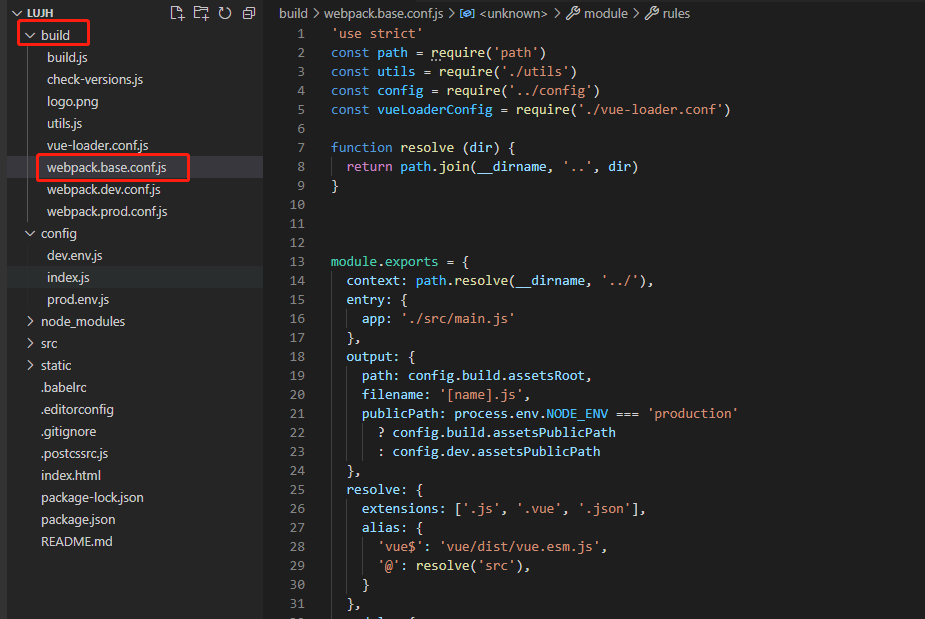
文件解析如下:
'use strict' const path = require('path') //node的path模块,对路径进行处理 const utils = require('./utils') //引入的工具包 const config = require('../config')//引入 config下的index.js文件 const vueLoaderConfig = require('./vue-loader.conf') //根据NODE_ENV这个变量分析是否是生产环境,然后根据不同的环境来加载,判断是否开启了sourceMap的功能 function resolve (dir) { return path.join(__dirname, '..', dir) //对路径进行处理,获取到绝对路径 } module.exports = { context: path.resolve(__dirname, '../'), //对路径进行处理,跳到当前项目的根目录下 entry: { //入口文件,即项目要引入哪个js文件 app: './src/main.js' //因为 context 中已经跳到了当前项目的根目录下,所以这里的路径是以 ./src 开头 }, output: { //输出文件,即项目要输出到哪里去 path: config.build.assetsRoot, //输出到根目录下的dist问价夹里,具体地址可以在config下的index.js中进行修改 filename: '[name].js', //以文件的原始名输出 publicPath: process.env.NODE_ENV === 'production' //根据process.env.NODE_ENV 来判断是生产模式还是开发模式,将最终打包的项目要放到服务器的什么地方,默认是 '/' 即服务器的根目录下。 ? config.build.assetsPublicPath : config.dev.assetsPublicPath }, resolve: { extensions: ['.js', '.vue', '.json'], //简化一些文件名,引入文件时可以不带后缀名 alias: { 'vue$': 'vue/dist/vue.esm.js', '@': resolve('src'), //简化文件的引入问题,如:本文件中要引入 src下的config里的index.js,你就可以这样引入:@/config/index.js } }, module: { rules: [ // 配置各种loader,来处理对应的文件 { test: /\.vue$/, //使用vue-loader处理以.vue结束的文件 loader: 'vue-loader', options: vueLoaderConfig }, { test: /\.js$/, //使用babel-loader处理以.js结束的文件,即js文件 loader: 'babel-loader', include: [resolve('src'), resolve('test'), resolve('node_modules/webpack-dev-server/client')] }, { test: /\.(png|jpe?g|gif|svg)(\?.*)?$/, //使用url-loader处理各种格式的图片资源,最大限制10000KB,这里不处理src同级目录下的static里的图片。 loader: 'url-loader', options: { limit: 10000, name: utils.assetsPath('img/[name].[hash:7].[ext]') //将处理后的放在img文件下,并且加上7位hash值。 } }, { test: /\.(mp4|webm|ogg|mp3|wav|flac|aac)(\?.*)?$/, //使用url-loader处理视频文件。 loader: 'url-loader', options: { limit: 10000, name: utils.assetsPath('media/[name].[hash:7].[ext]') } }, { test: /\.(woff2?|eot|ttf|otf)(\?.*)?$/, //使用url-loader处理字体文件。 loader: 'url-loader', options: { limit: 10000, name: utils.assetsPath('fonts/[name].[hash:7].[ext]') } } ] }, node: { // prevent webpack from injecting useless setImmediate polyfill because Vue // source contains it (although only uses it if it's native). setImmediate: false, // prevent webpack from injecting mocks to Node native modules // that does not make sense for the client dgram: 'empty', fs: 'empty', net: 'empty', tls: 'empty', child_process: 'empty' } }
4、build/webpack.prod.config.js:
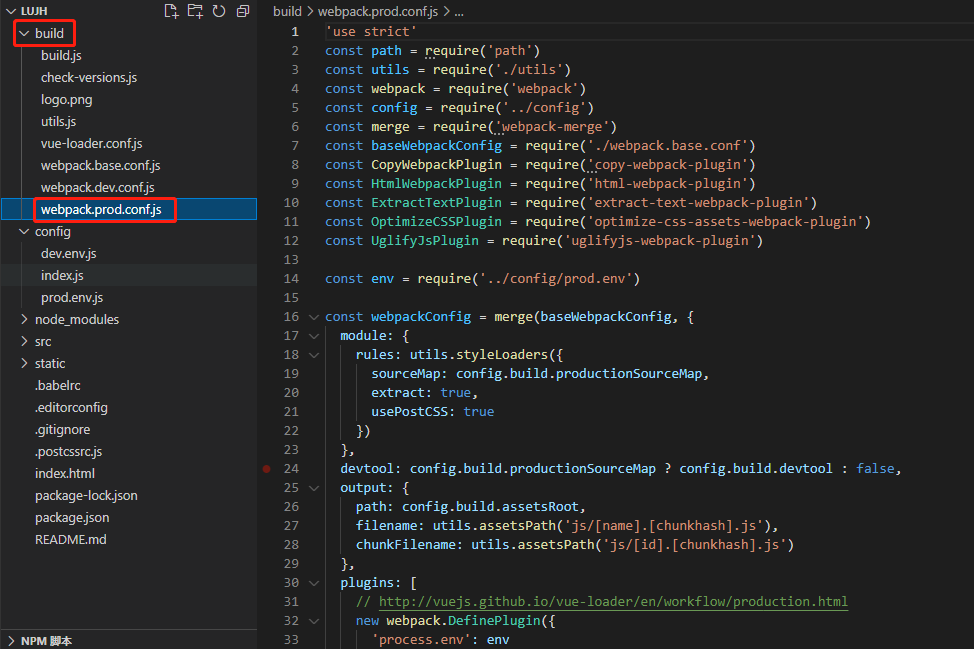
文件解析如下:
'use strict' const path = require('path') const utils = require('./utils') const webpack = require('webpack') const config = require('../config') const merge = require('webpack-merge') const baseWebpackConfig = require('./webpack.base.conf') const CopyWebpackPlugin = require('copy-webpack-plugin') const HtmlWebpackPlugin = require('html-webpack-plugin') const ExtractTextPlugin = require('extract-text-webpack-plugin') //抽离css样式,防止将样式打包在js中引起页面样式加载错乱的现象 const OptimizeCSSPlugin = require('optimize-css-assets-webpack-plugin')//主要是用来压缩css文件 const UglifyJsPlugin = require('uglifyjs-webpack-plugin') //对js文件进行压缩 const env = require('../config/prod.env') const webpackConfig = merge(baseWebpackConfig, { module: { rules: utils.styleLoaders({ sourceMap: config.build.productionSourceMap, extract: true, usePostCSS: true }) }, devtool: config.build.productionSourceMap ? config.build.devtool : false, // 方便开发审查问题代码,推荐在开发环境使用,生产环境不使用 output: { // 出口 path: config.build.assetsRoot, filename: utils.assetsPath('js/[name].[chunkhash].js'), chunkFilename: utils.assetsPath('js/[id].[chunkhash].js') }, plugins: [ // http://vuejs.github.io/vue-loader/en/workflow/production.html new webpack.DefinePlugin({ 'process.env': env }), new UglifyJsPlugin({ uglifyOptions: { //配置项 compress: { warnings: false } }, sourceMap: config.build.productionSourceMap, //使用sourceMap将错误消息位置映射到模块(这会减慢编译速度)。 parallel: true //启用/禁用多进程并行运行,启用后会提高构建速度 }), new ExtractTextPlugin({ filename: utils.assetsPath('css/[name].[contenthash].css'), allChunks: true, }), // Compress extracted CSS. We are using this plugin so that possible // duplicated CSS from different components can be deduped. new OptimizeCSSPlugin({ cssProcessorOptions: config.build.productionSourceMap ? { safe: true, map: { inline: false } } //判断是否生成内联映射,如果生成则会生成一个source-map文件 : { safe: true } }), // generate dist index.html with correct asset hash for caching. // you can customize output by editing /index.html // see https://github.com/ampedandwired/html-webpack-plugin new HtmlWebpackPlugin({ filename: config.build.index, //将会生成一个index.html文件,放到dist文件下 template: 'index.html', inject: true, //将所有js资源放在body标签的底部 minify: { //控制是否进行压缩 removeComments: true, //删除所有的注释 collapseWhitespace: true, //折叠构成文档树中文本节点的空白 removeAttributeQuotes: true //尽可能删除属性周围的引号 // more options: // https://github.com/kangax/html-minifier#options-quick-reference }, // necessary to consistently work with multiple chunks via CommonsChunkPlugin chunksSortMode: 'dependency' //允许控制块在包含到HTML之前按照依赖排序 }), // keep module.id stable when vendor modules does not change new webpack.HashedModuleIdsPlugin(), //该插件会根据模块的相对路径生成一个四位数的hash作为模块id, 建议用于生产环境。 // enable scope hoisting new webpack.optimize.ModuleConcatenationPlugin(),//启用作用域提升,让代码文件更小、运行的更快 // split vendor js into its own file new webpack.optimize.CommonsChunkPlugin({ //主要是用来提取第三方库和公共模块,避免首屏加载的bundle文件或者按需加载的bundle文件体积过大,从而导致加载时间过长 name: 'vendor', minChunks (module) { // any required modules inside node_modules are extracted to vendor return ( module.resource && /\.js$/.test(module.resource) && module.resource.indexOf( path.join(__dirname, '../node_modules') ) === 0 ) } }), // extract webpack runtime and module manifest to its own file in order to // prevent vendor hash from being updated whenever app bundle is updated new webpack.optimize.CommonsChunkPlugin({ name: 'manifest', minChunks: Infinity }), // This instance extracts shared chunks from code splitted chunks and bundles them // in a separate chunk, similar to the vendor chunk // see: https://webpack.js.org/plugins/commons-chunk-plugin/#extra-async-commons-chunk new webpack.optimize.CommonsChunkPlugin({ name: 'app', async: 'vendor-async', children: true, minChunks: 3 }), // copy custom static assets new CopyWebpackPlugin([ //复制模块 { from: path.resolve(__dirname, '../static'), to: config.build.assetsSubDirectory, ignore: ['.*'] } ]) ] }) if (config.build.productionGzip) { const CompressionWebpackPlugin = require('compression-webpack-plugin') webpackConfig.plugins.push( new CompressionWebpackPlugin({ asset: '[path].gz[query]', algorithm: 'gzip', test: new RegExp( '\\.(' + config.build.productionGzipExtensions.join('|') + ')$' ), threshold: 10240, minRatio: 0.8 }) ) } if (config.build.bundleAnalyzerReport) { const BundleAnalyzerPlugin = require('webpack-bundle-analyzer').BundleAnalyzerPlugin webpackConfig.plugins.push(new BundleAnalyzerPlugin()) } module.exports = webpackConfig
5、我们执行打包命令 npm run build ,就是执行build里面的文件,build.js中引入了webpack.prod.config.js,因此build.js才是生产环境所需的webpack文件。
build/build.js文件解析如下:

'use strict' require('./check-versions')() //该文件用于检测node和npm的版本,实现版本依赖 process.env.NODE_ENV = 'production' // 生产环境 const ora = require('ora') //在node端加载动画模块 const rm = require('rimraf') //用来删除文件和文件夹的 const path = require('path') const chalk = require('chalk') //修改控制台中字符串的样式 const webpack = require('webpack') const config = require('../config') const webpackConfig = require('./webpack.prod.conf') // 生产环境的配置 const spinner = ora('building for production...') //设置一个动画的内容为 "building for production..." spinner.start() //加载动画 rm(path.join(config.build.assetsRoot, config.build.assetsSubDirectory), err => { //利用 rm 模块先删除dist文件再生成新文件,因为有时候会使用hash来命名,删除整个文件可避免冗余 if (err) throw err webpack(webpackConfig, (err, stats) => { //将一下配置内容与 webpack.prod.conf.js中的配置进行合并 spinner.stop() //停止动画 if (err) throw err process.stdout.write(stats.toString({ colors: true, modules: false, children: false, // If you are using ts-loader, setting this to true will make TypeScript errors show up during build. chunks: false, chunkModules: false }) + '\n\n') if (stats.hasErrors()) { console.log(chalk.red(' Build failed with errors.\n')) process.exit(1) } console.log(chalk.cyan(' Build complete.\n')) console.log(chalk.yellow( ' Tip: built files are meant to be served over an HTTP server.\n' + ' Opening index.html over file:// won\'t work.\n' )) }) })
6、build/check-versions.js: 检测node和npm的版本,实现版本依赖
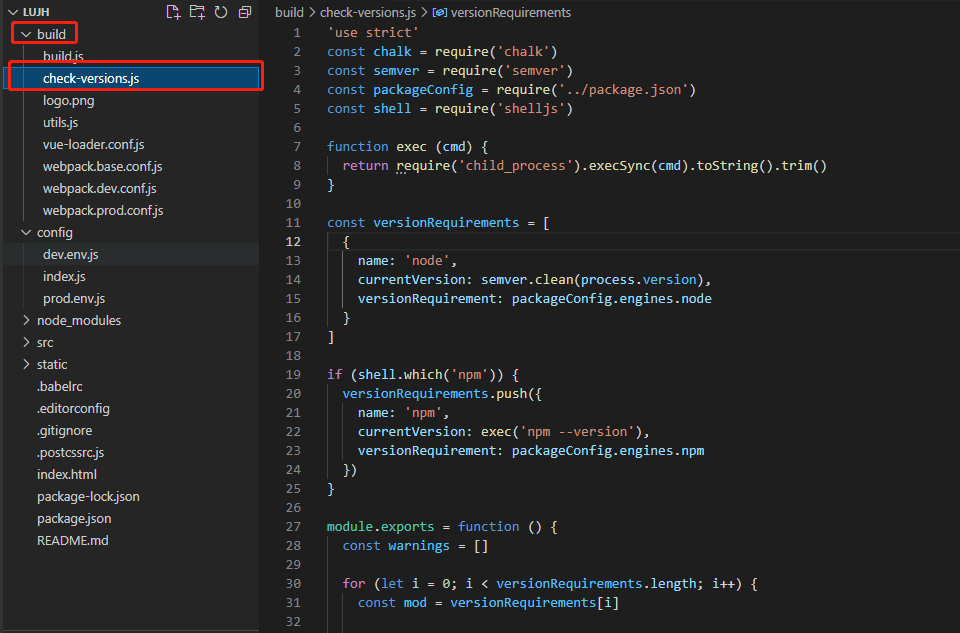
文件解析:
'use strict' // 该文件用于检测node和npm的版本,实现版本依赖 const chalk = require('chalk') //node.js中的模块,作用是修改控制台中字符串的样式 const semver = require('semver') //node.js中的模块,对版本进行检查 const packageConfig = require('../package.json') //引入page.json文件 const shell = require('shelljs') function exec (cmd) { //通过child_process模块的新建子进程,执行 Unix 系统命令后转成没有空格的字符串 return require('child_process').execSync(cmd).toString().trim() } const versionRequirements = [ { name: 'node', currentVersion: semver.clean(process.version), //使用semver格式化版本 versionRequirement: packageConfig.engines.node //获取package.json中设置的node版本 } ] if (shell.which('npm')) { versionRequirements.push({ name: 'npm', currentVersion: exec('npm --version'), //自动调用npm --version命令,并且把参数返回给exec函数,从而获取纯净的版本号 versionRequirement: packageConfig.engines.npm }) } module.exports = function () { const warnings = [] for (let i = 0; i < versionRequirements.length; i++) { const mod = versionRequirements[i] if (!semver.satisfies(mod.currentVersion, mod.versionRequirement)) { //如果上面的版本号不符合package.json文件中指定的版本号,就执行下面错误提示的代码 warnings.push(mod.name + ': ' + chalk.red(mod.currentVersion) + ' should be ' + chalk.green(mod.versionRequirement) ) } } if (warnings.length) { console.log('') console.log(chalk.yellow('To use this template, you must update following to modules:')) console.log() for (let i = 0; i < warnings.length; i++) { const warning = warnings[i] console.log(' ' + warning) } console.log() process.exit(1) } }
7、build/vue-loader.conf.js:
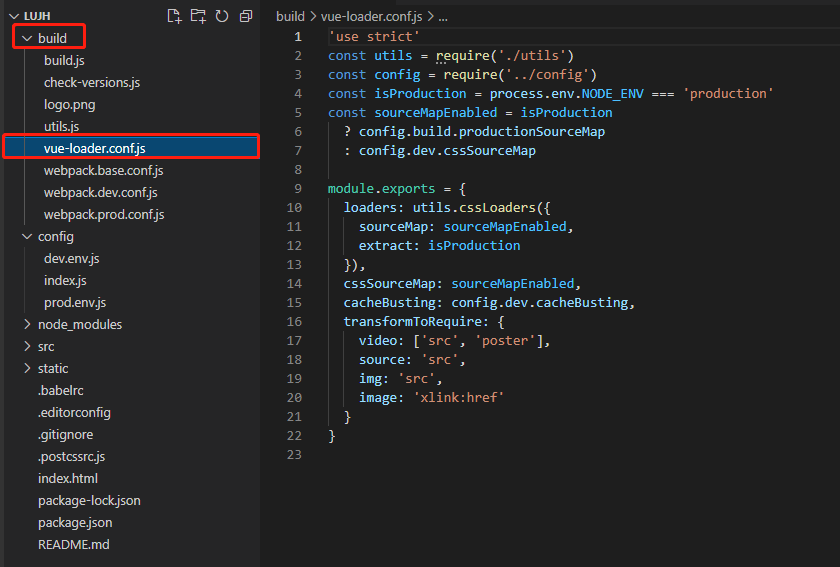
文件解析如下:
'use strict' //根据NODE_ENV这个变量分析是否是生产环境,然后根据不同的环境来加载,判断是否开启了sourceMap的功能。方便之后在cssLoaders中加上sourceMap功能。然后判断是否设置了cacheBusting属性, // 它指的是缓存破坏,特别是进行sourceMap debug时,设置成false是非常有帮助的。最后就是一个转化请求的内容,video、source、img、image等的属性进行配置。具体的还是需要去了解vue-loader这个 // webpack的loader加载器 const utils = require('./utils') const config = require('../config') const isProduction = process.env.NODE_ENV === 'production' const sourceMapEnabled = isProduction ? config.build.productionSourceMap : config.dev.cssSourceMap //处理项目中的css文件,生产环境和测试环境默认是打开sourceMap,而extract中的提取样式到单独文件只有在生产环境中才需要 module.exports = { loaders: utils.cssLoaders({ sourceMap: sourceMapEnabled, extract: isProduction }), cssSourceMap: sourceMapEnabled, cacheBusting: config.dev.cacheBusting, transformToRequire: {//在模版编译过程中,编译器可以将某些属性,如 src 路径,转换为require调用,以便目标资源可以由 webpack 处理. video: ['src', 'poster'], source: 'src', img: 'src', image: 'xlink:href' } }
8、build/util.js
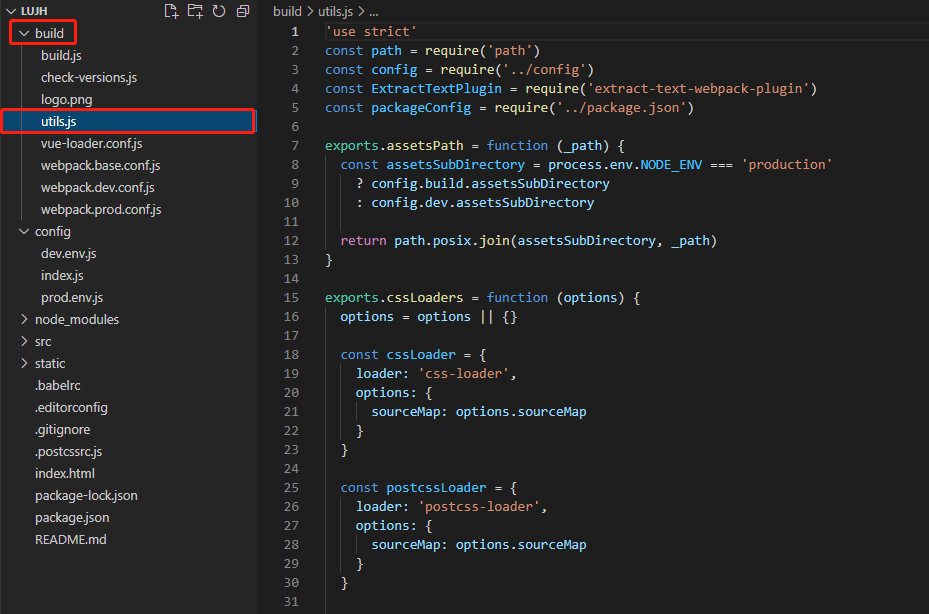
文件解析如下:
'use strict' const path = require('path') const config = require('../config') const ExtractTextPlugin = require('extract-text-webpack-plugin') ////抽离css样式,防止将样式打包在js中引起页面样式加载错乱的现象 const packageConfig = require('../package.json') //导出文件的位置,根据环境判断开发环境和生产环境,为config文件中index.js文件中定义的build.assetsSubDirectory或 exports.assetsPath = function (_path) { const assetsSubDirectory = process.env.NODE_ENV === 'production' ? config.build.assetsSubDirectory : config.dev.assetsSubDirectory return path.posix.join(assetsSubDirectory, _path) } //使用了css-loader和postcssLoader,通过options.usePostCSS属性来判断是否使用postcssLoader中压缩等方法 exports.cssLoaders = function (options) { //导出css-loader options = options || {} const cssLoader = { loader: 'css-loader', options: { sourceMap: options.sourceMap } } const postcssLoader = { loader: 'postcss-loader', options: { sourceMap: options.sourceMap } } // generate loader string to be used with extract text plugin function generateLoaders (loader, loaderOptions) { const loaders = options.usePostCSS ? [cssLoader, postcssLoader] : [cssLoader] //根据传入的参数判断是使用cssLoader、 postcssLoader还是只使用 cssLoader if (loader) { loaders.push({ loader: loader + '-loader', options: Object.assign({}, loaderOptions, { //将后面的两个对象合并后再进行复制 sourceMap: options.sourceMap }) }) } // Extract CSS when that option is specified // (which is the case during production build) if (options.extract) { return ExtractTextPlugin.extract({ use: loaders, fallback: 'vue-style-loader' }) } else { return ['vue-style-loader'].concat(loaders) } } // https://vue-loader.vuejs.org/en/configurations/extract-css.html return { css: generateLoaders(), postcss: generateLoaders(), less: generateLoaders('less'), sass: generateLoaders('sass', { indentedSyntax: true }), scss: generateLoaders('sass'), stylus: generateLoaders('stylus'), styl: generateLoaders('stylus') } } // Generate loaders for standalone style files (outside of .vue) exports.styleLoaders = function (options) { const output = [] const loaders = exports.cssLoaders(options) for (const extension in loaders) { const loader = loaders[extension] output.push({ test: new RegExp('\\.' + extension + '$'), use: loader }) } return output } exports.createNotifierCallback = () => { const notifier = require('node-notifier') return (severity, errors) => { if (severity !== 'error') return const error = errors[0] const filename = error.file && error.file.split('!').pop() notifier.notify({ title: packageConfig.name, message: severity + ': ' + error.name, subtitle: filename || '', icon: path.join(__dirname, 'logo.png') }) } }
9、config/index.js: 生产 和 开发 环境下webpack的公共配置文件
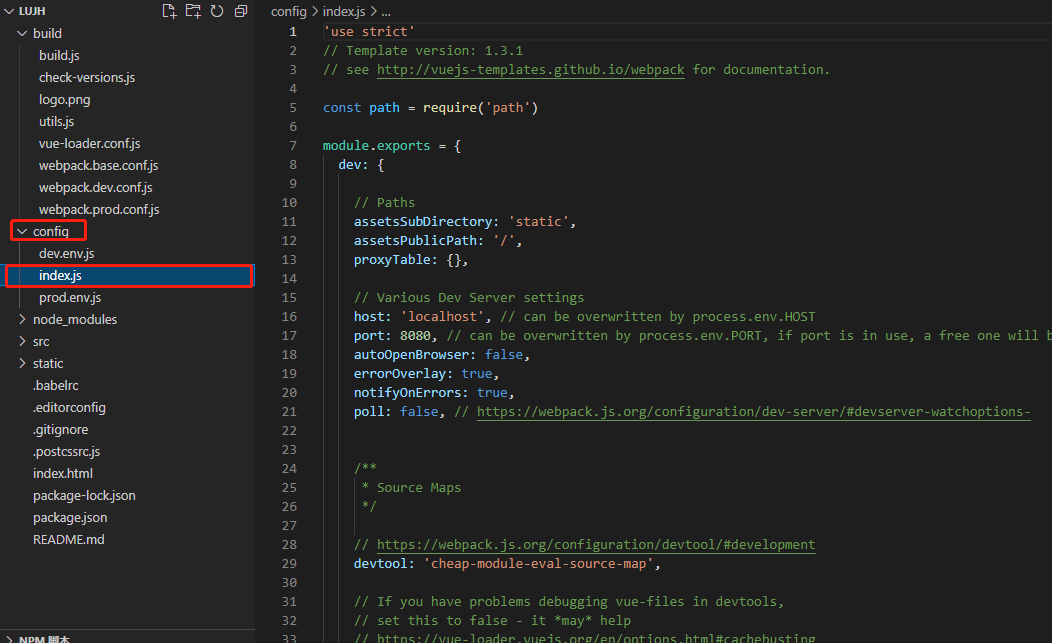
文件解析如下:
const path = require('path') module.exports = { dev: { //开发环境下的配置 // Paths assetsSubDirectory: 'static', //子目录,一般存放css,js,image等文件 assetsPublicPath: '/', //根目录 proxyTable: {}, //在这里使用代理解决跨越问题 // Various Dev Server settings host: 'localhost', // 域名 port: 8080, // 开启的端口号,默认是8080 autoOpenBrowser: true, //是否自动打开浏览器 errorOverlay: true, //浏览器错误提示 notifyOnErrors: true, //跨平台错误提示 poll: false, // 使用文件系统(file system)获取文件改动的通知devServer.watchOptions /** * Source Maps */ // https://webpack.js.org/configuration/devtool/#development devtool: 'cheap-module-eval-source-map',//增加调试,该属性为原始源代码(仅限行)不可在生产环境中使用 cacheBusting: true,//使缓存失效 cssSourceMap: true //代码压缩后进行调bug定位将非常困难,于是引入sourcemap记录压缩前后的位置信息记录,当产生错误时直接定位到未压缩前的位置,将大大的方便我们调试 }, build: { //生产发环境下的配置 // Template for index.html index: path.resolve(__dirname, '../dist/index.html'), //index.html编译后生成的位置和名字 // Paths assetsRoot: path.resolve(__dirname, '../dist'),//编译后存放生成环境代码的位置 assetsSubDirectory: 'static', //js,css,images存放文件夹名 assetsPublicPath: '/', //发布的根目录,通常本地打包dist后打开文件会报错,此处修改为./。如果是上线的文件,可根据文件存放位置进行更改路径 productionSourceMap: true, devtool: '#source-map', productionGzip: false, productionGzipExtensions: ['js', 'css'], bundleAnalyzerReport: process.env.npm_config_report } }
10、config/dev.env.js:文件
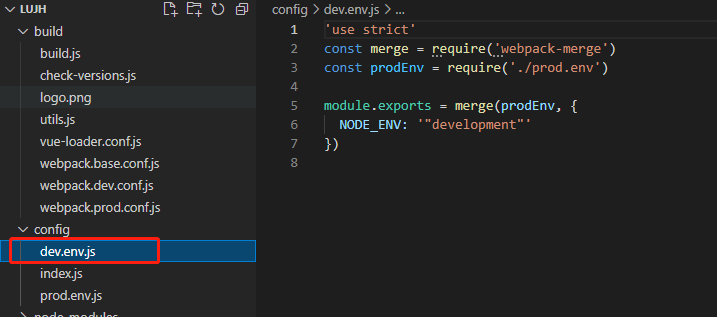
文件解析如下:
'use strict' // 当在开发环境下引用(webpack.dev.config.js中的plugin中)的是此文件,此文件指定了 开发模式: node-env , //利用merge方法将prod.env.js与本文件进行合并,在开发模式下输出 NODE_ENV="development" //webpack.dev.config.js中的plugin引用如下: // new webpack.DefinePlugin({ // 'process.env': require('../config/dev.env') // }) const merge = require('webpack-merge') const prodEnv = require('./prod.env') module.exports = merge(prodEnv, { NODE_ENV: '"development"' })
11、config/prod.env.js:
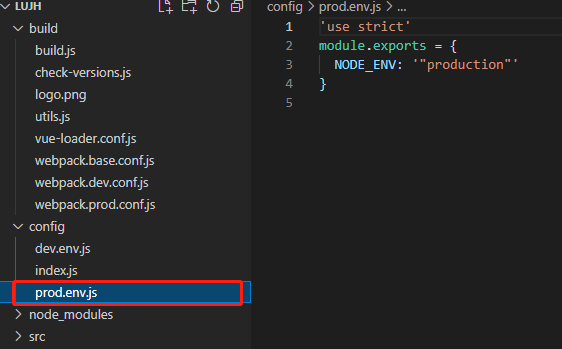
文件解析如下:
'use strict' // 在生产模式下调用此文件 // 在webpack.prod.config.js中的plugin中引用如下: //const env = require('../config/prod.env') // new webpack.DefinePlugin({ // 'process.env': env // }), module.exports = { NODE_ENV: '"production"' }
12 、node_modules文件夹:该文件夹下存放的是node的一些依赖模块,比如:require模块、path模块、http-proxy-middleware模块,还有一些我们通过npm安装的插件模块,比如vue、md5、vue-cli、ivew等。
13.、src文件夹: 该文件夹下面存放的是我们项目代码以及一些文件,components文件夹存放了我们自己写的组件,router文件夹里面存放了路由配置,mian.js是整个项目的入口js,在build文件夹下的webpack.dev.config.js中的entry中有配置(
例子2:
vue2.0 或 vue3.0
vue cli v4.5.15 初始化项目
使用命令:vue create lujh(项目名称)
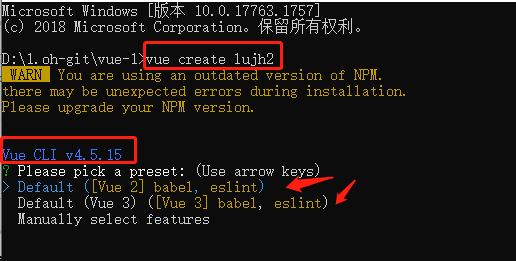
选择vue2或者vue3,安装包差不多,版本不一样

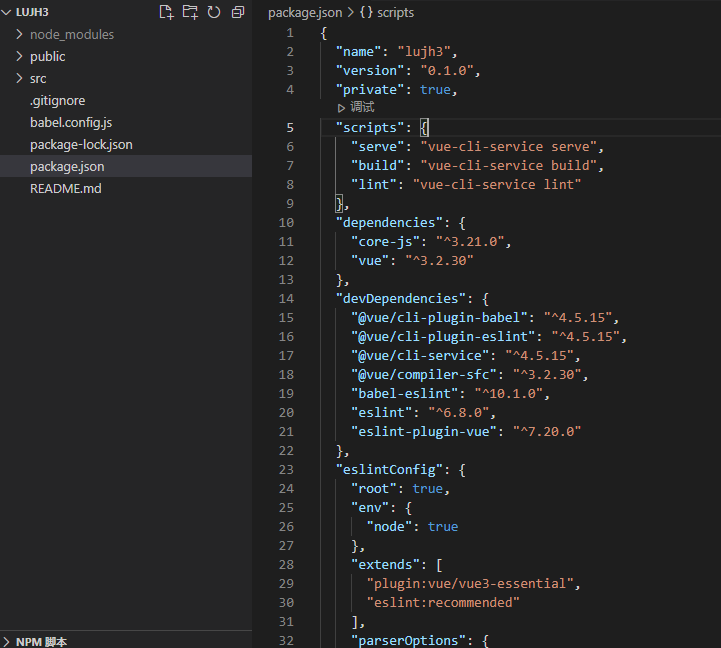
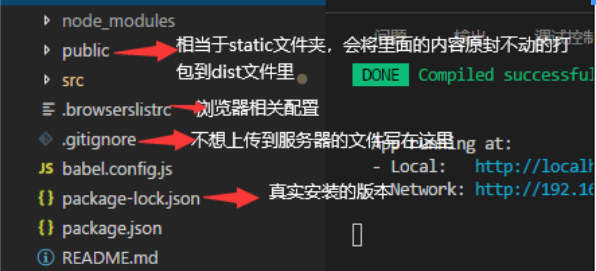

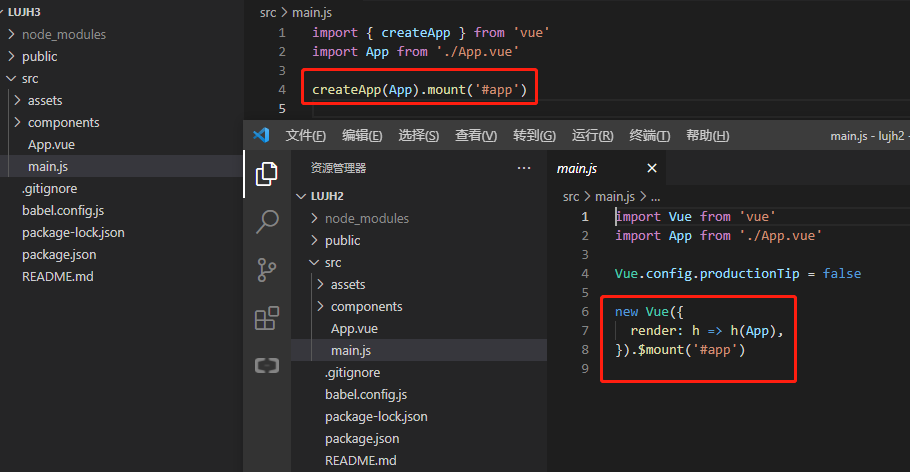
修改配置,因为vue-cli3把配置文件都给隐藏了,隐藏到哪里了?
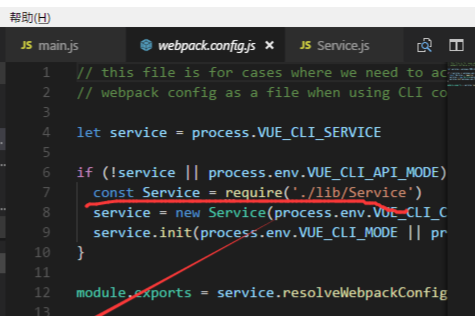
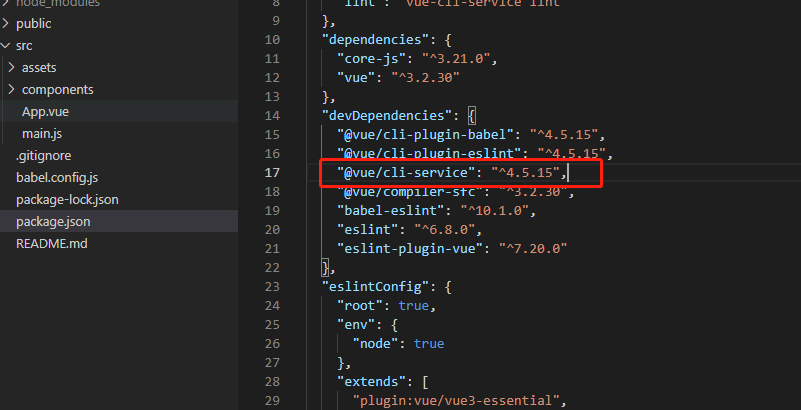
我们如何修改配置?
方法一:在隐藏的文件夹直接修改
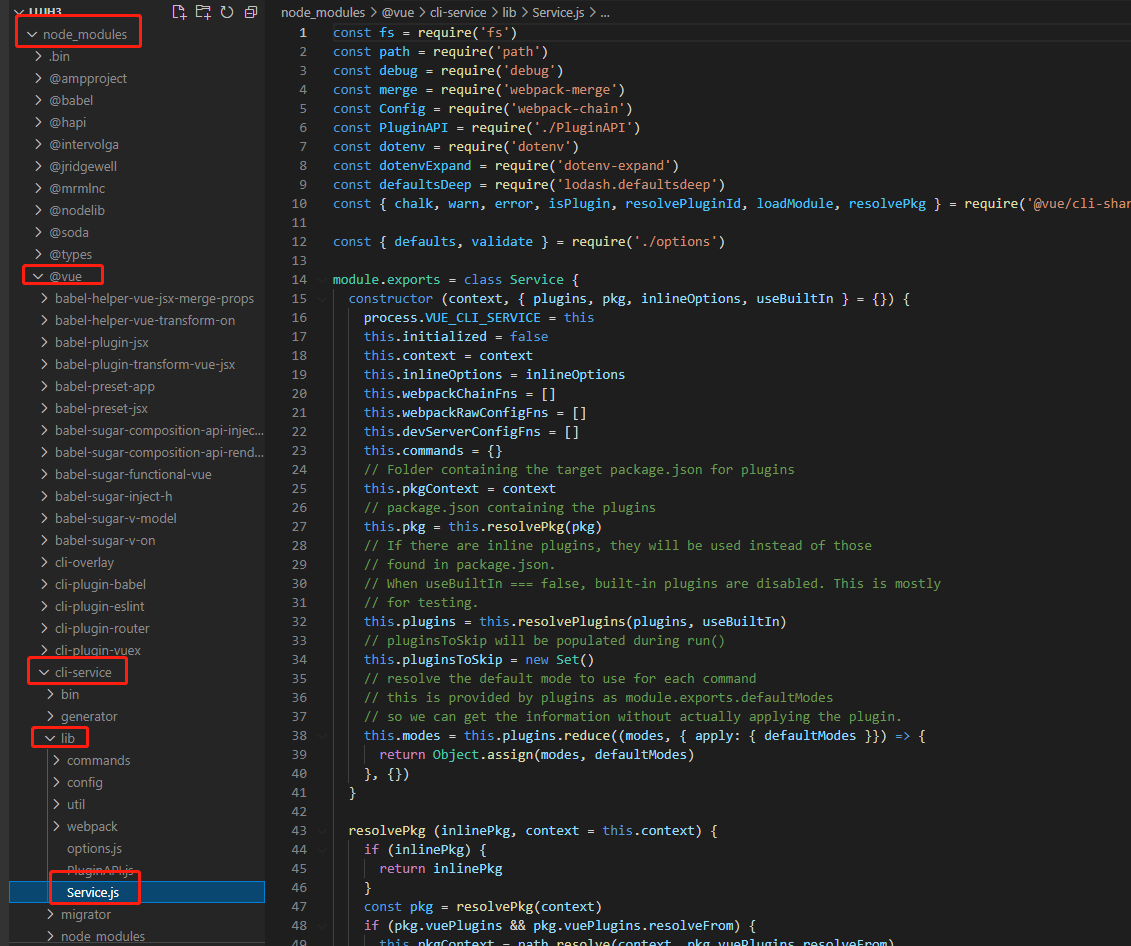



【推荐】国内首个AI IDE,深度理解中文开发场景,立即下载体验Trae
【推荐】编程新体验,更懂你的AI,立即体验豆包MarsCode编程助手
【推荐】抖音旗下AI助手豆包,你的智能百科全书,全免费不限次数
【推荐】轻量又高性能的 SSH 工具 IShell:AI 加持,快人一步
· TypeScript + Deepseek 打造卜卦网站:技术与玄学的结合
· 阿里巴巴 QwQ-32B真的超越了 DeepSeek R-1吗?
· 【译】Visual Studio 中新的强大生产力特性
· 【设计模式】告别冗长if-else语句:使用策略模式优化代码结构
· AI与.NET技术实操系列(六):基于图像分类模型对图像进行分类